| Hollywoodland | Mar 2 2017 |

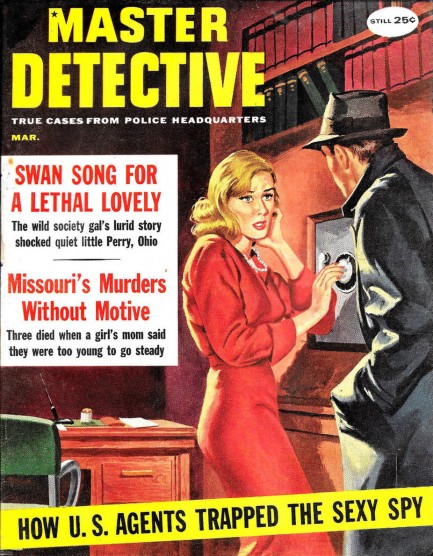
This Master Detective published today in 1960 has a nice cover by Al Drule, and inside the issue are several interesting stories, but the one we're looking at today is “The Crime that Wasn't in the Script,” about a murder that took place during the filming of John Wayne's western The Alamo. The story is kind of forgotten, but basically, an actress named LaJean Etheridge was killed by her boyfriend Chester Harvey Smith, who was angry that Etheridge had decided to move closer to the movie set in Brackettville, Texas. Such a killing is impossible to understand under any circumstances, but putting on your jealous madman cap for a second you can picture a possessive man losing it over his girlfriend moving thousands of miles away. Like if someone told you the story you'd nod and go, “Umm hmm,” because you could see it.
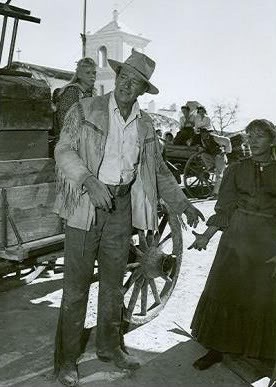 But Etheridge wasn't moving thousands of miles. She and Smith had both scored work as extras on The Alamo, had traveled from Hollywood together, and were living in Spofford, Texas with three other extras in lodgings set up by Wayne's Batjac Productions. Etheridge had decided to move from Spofford to Fort Clark, ten miles north, a relocation precipitated by her landing a larger part in the film. Was she simply moving closer to the set to facilitate the changed demands of her role? Or was she leaving her boyfriend? Still wearing your jealous madman cap, you can picture Smith believing the latter. Etheridge would be out of sight, living with unknowns, possibly having fun with production staff and carousing with handsome actors. But she never got the chance—as she was packing Smith stabbed her in the chest with a Bowie knife, and she died on the scene. He was arrested when police arrived fifteen minutes later, pled guilty to murder, and was sentenced to thirty years in prison.
But Etheridge wasn't moving thousands of miles. She and Smith had both scored work as extras on The Alamo, had traveled from Hollywood together, and were living in Spofford, Texas with three other extras in lodgings set up by Wayne's Batjac Productions. Etheridge had decided to move from Spofford to Fort Clark, ten miles north, a relocation precipitated by her landing a larger part in the film. Was she simply moving closer to the set to facilitate the changed demands of her role? Or was she leaving her boyfriend? Still wearing your jealous madman cap, you can picture Smith believing the latter. Etheridge would be out of sight, living with unknowns, possibly having fun with production staff and carousing with handsome actors. But she never got the chance—as she was packing Smith stabbed her in the chest with a Bowie knife, and she died on the scene. He was arrested when police arrived fifteen minutes later, pled guilty to murder, and was sentenced to thirty years in prison.Etheridge's part in The Alamo was left on the cutting room floor. No surprise. The murder caused enough bad publicity as it was, so naturally there was no way she could have remained in the film. It wasn't until an extended version was released in 1993 that her role as Mrs. Guy was seen by movie fans. Though the story of the murder has
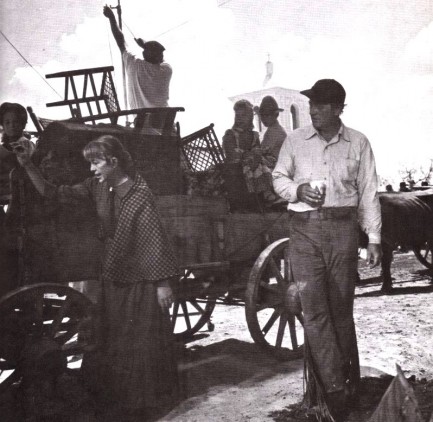 faded somewhat, author John Hegenberger used the events as the backdrop for a 2017 crime novel called Stormfall. Chester Harvey Smith, John Wayne, and others are characters, and the star is Hegenberger's detective creation Stan Wade. The book opens with the murder, and Etheridge uttering her final words to Smith before she dies. What were the words? According to the statement Smith gave police, Etheridge said, mortally wounded and bleeding to death, “I love you.” You can take off your jealous madman cap now.
faded somewhat, author John Hegenberger used the events as the backdrop for a 2017 crime novel called Stormfall. Chester Harvey Smith, John Wayne, and others are characters, and the star is Hegenberger's detective creation Stan Wade. The book opens with the murder, and Etheridge uttering her final words to Smith before she dies. What were the words? According to the statement Smith gave police, Etheridge said, mortally wounded and bleeding to death, “I love you.” You can take off your jealous madman cap now. | Vintage Pulp | Dec 16 2014 |

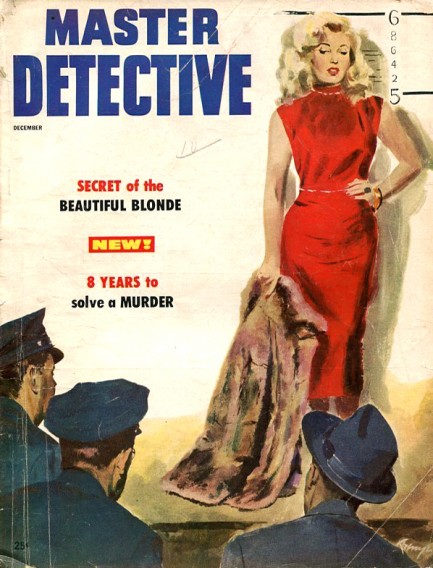
Above, a nice cover of Master Detective from December 1953 with art by the always brilliant Barye Phillips. The magazine launched in 1924, but this is the earliest cover we’ve shared. We’ll dig a bit and see what we can find going back into the 1940s and earlier. By 1954 the covers became considerably more text heavy, which makes nearly blank examples like this worth looking for. We’ll see what we find.
| Vintage Pulp | Jun 14 2013 |

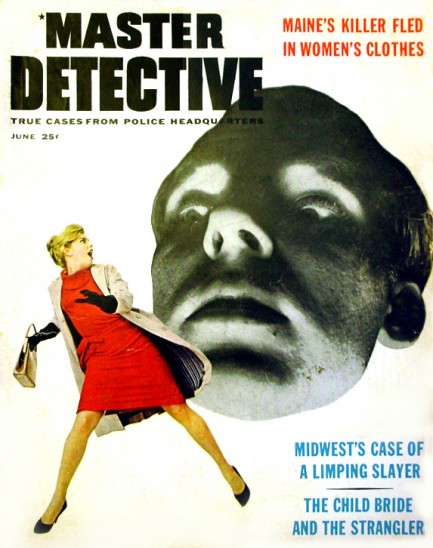
Here's an amazing cover of Master Detective published this month in 1962 featuring a woman being menaced by a giant disembodied head. Design-wise, we think this is inspired stuff. There are more than one hundred true crime magazine covers inside Pulp Int., and you can see them in chronological order by clicking here.
| Vintage Pulp | Feb 16 2013 |

In fashion they say it takes a confident woman to wear a red dress. In pulp, it takes a woman with a death wish. Below are fourteen pulp, adventure, and detective magazine covers illustrating that point, with art by Bud Parke, George Gross, Barye Phillips and others, as well as a couple of photo-illustrations.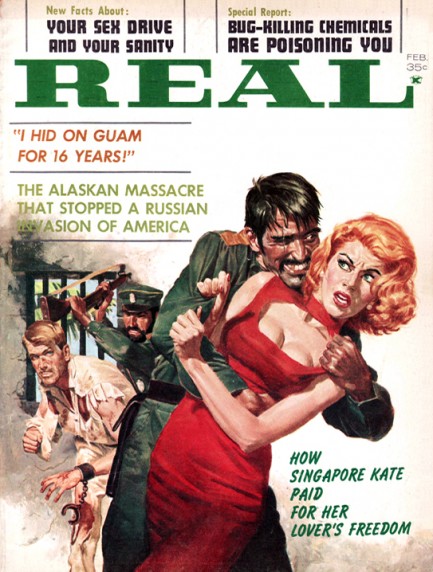
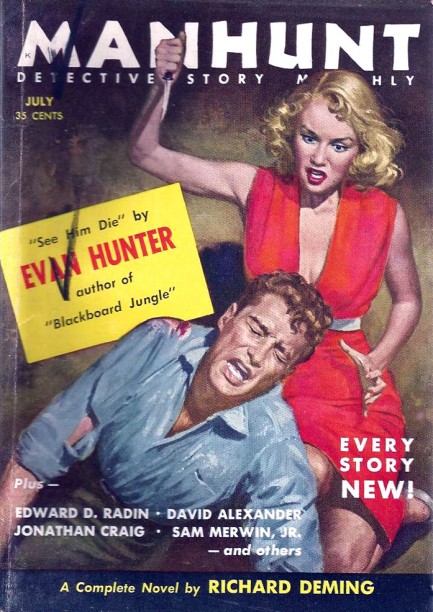
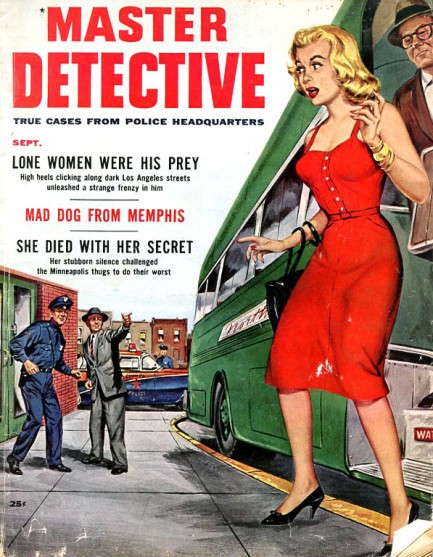
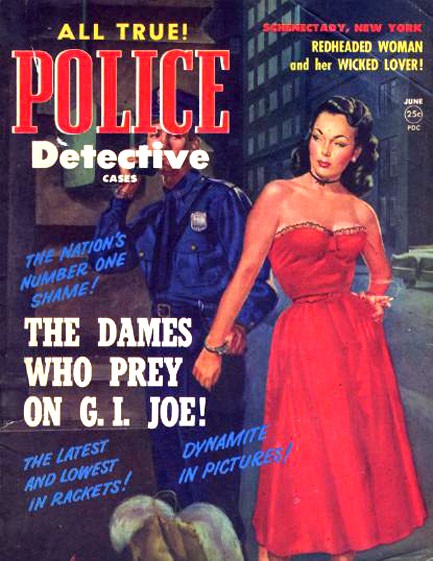
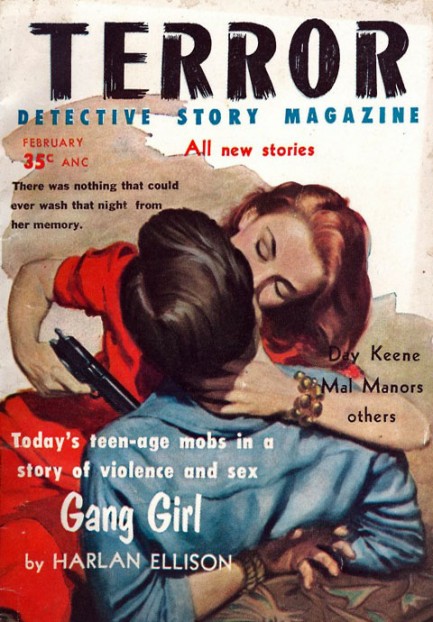
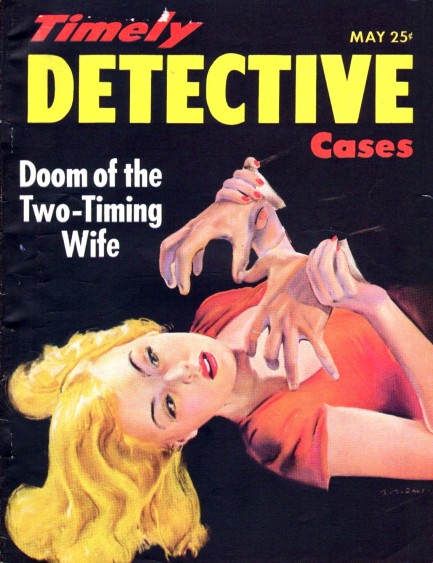
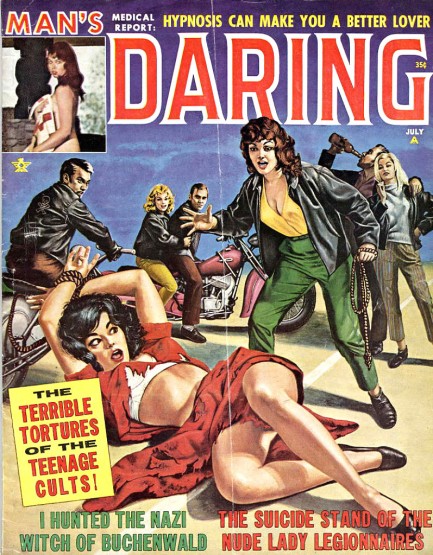

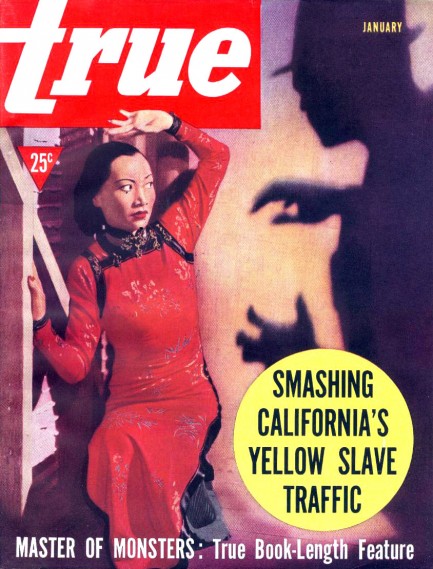
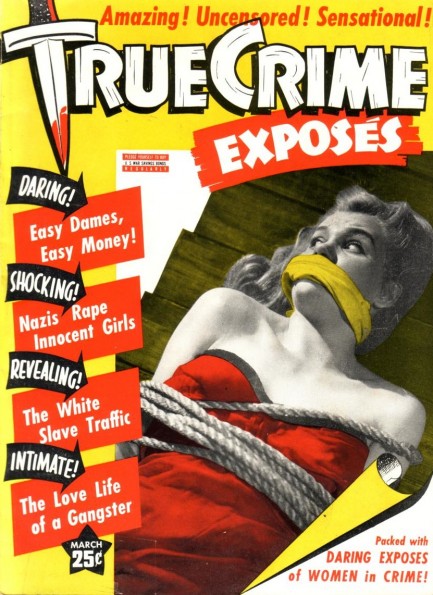
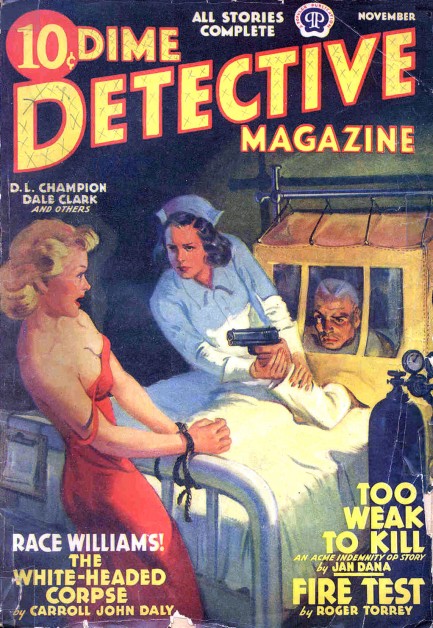
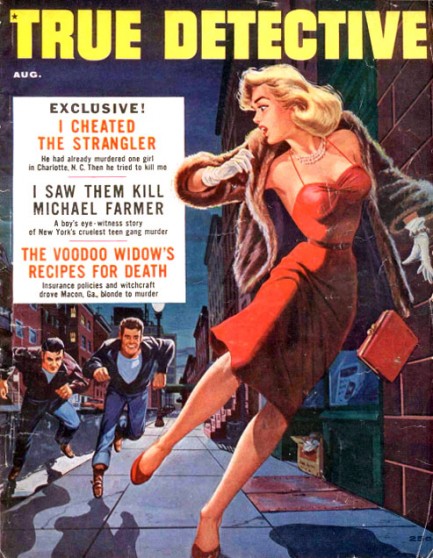
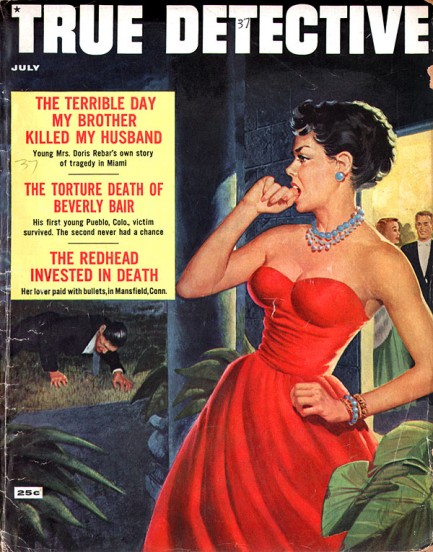
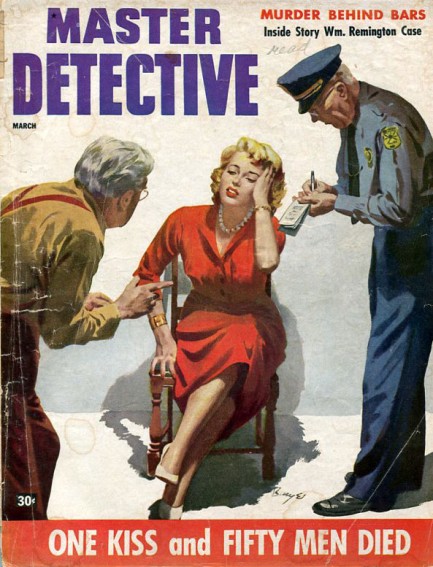
| The Naked City | Jul 31 2012 |

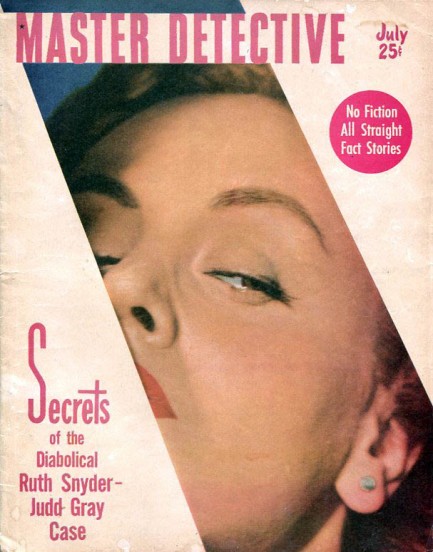
Above, a cover of Master Detective from July 1949, inside of which is a story on Ruth Snyder. In March 1927 Snyder garroted her husband with the help of her lover, a corset salesman named Henry Judd Gray. The couple had been after insurance money, but instead they were caught, tried, and sentenced to death by means of electrocution. On the day of the event, which took place at Sing Sing Prison, a photographer named Tom Howard entered the execution chamber as a witness. He was under assignment for the New York Daily News, but was actually based in Chicago, which meant he was unknown to prison authorities in the New York area. That was important, because Howard’s assignment was to illegally take a photo of Ruth Snyder’s execution, which had considerable tabloid value because she would be the first woman put to death at Sing Sing since 1899. Howard was ingeniously prepared—he had strapped a camera to his ankle, and had fed a shutter release up one pant leg to an accessible point inside his suit jacket. At the moment the executioner threw the switch, Howard lifted his pant leg and snapped the blurry photo below, which appeared the next day in the New York Daily News under a huge header that read simply: Dead! The issue was a sensation, the image became iconic, and Howard became nationally famous.
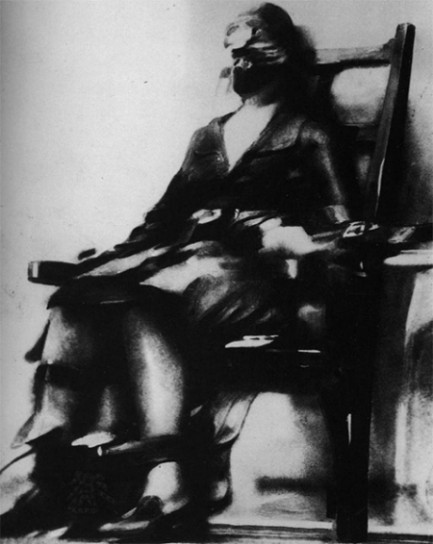
| Vintage Pulp | Dec 1 2011 |

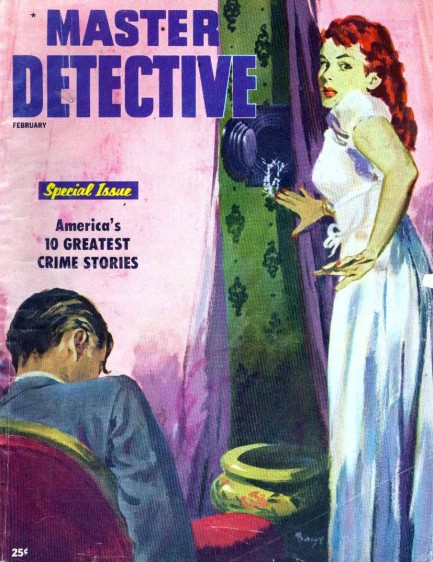
The woman who finds herself standing over a dead (or possibly drugged) man is a classic motif in true crime magazine cover art. Sometimes the woman is responsible for what's happened, while other times she simply has the bad luck to stumble into the situation. Covers of this type, you're probably already aware, fall under the category of Good Girl Art, with the “good” referring to the woman’s appearance, rather than her morals. Above and below are unlucky thirteen examples from mid-century crime magazines, with art from Barye Phillips, Jay Scott Pike, George Gross, Jack Rickard, and others. We borrowed one of these from Fringepop, and most of the rest we culled from online auctions where they’ve been languishing for months if not years. Feel inclined to collect a few classic true crime magazines? There are plenty of choices out there right now. Thanks to the original uploaders. 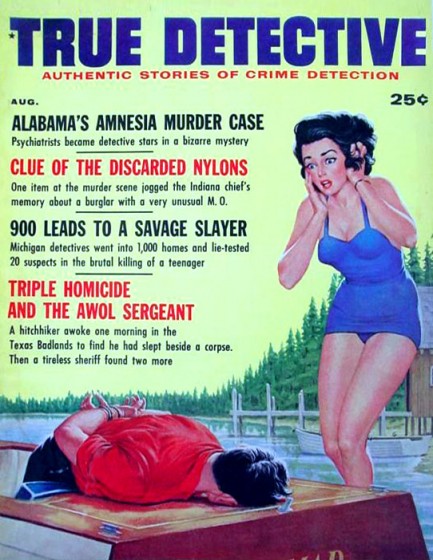
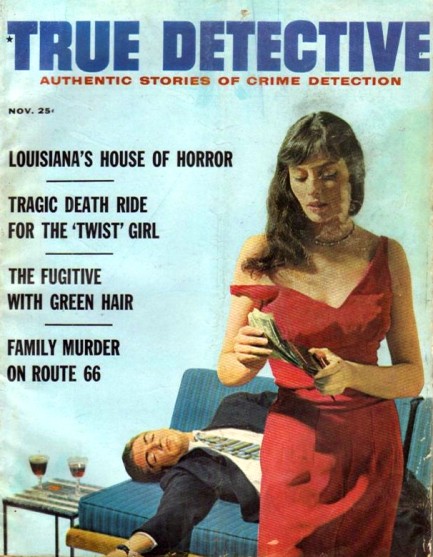
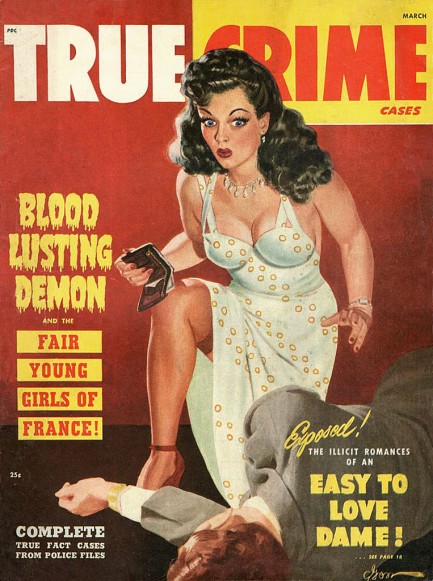
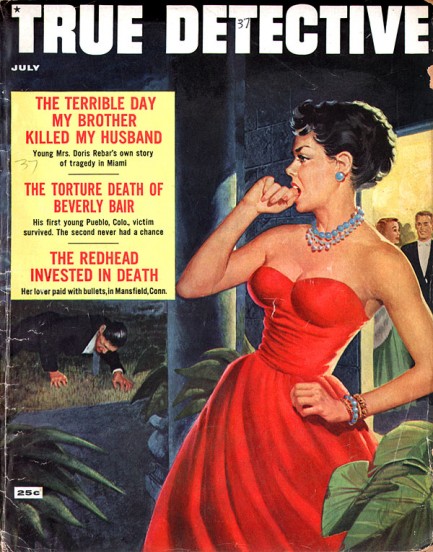
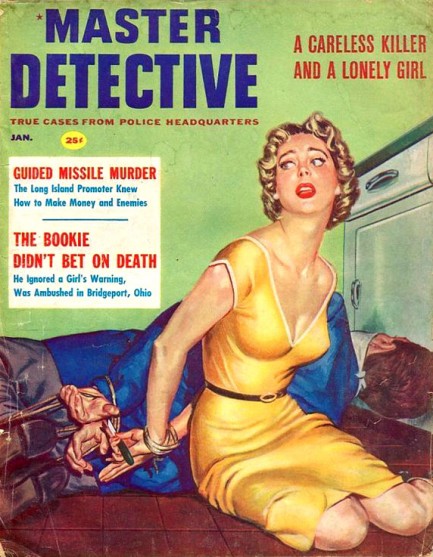
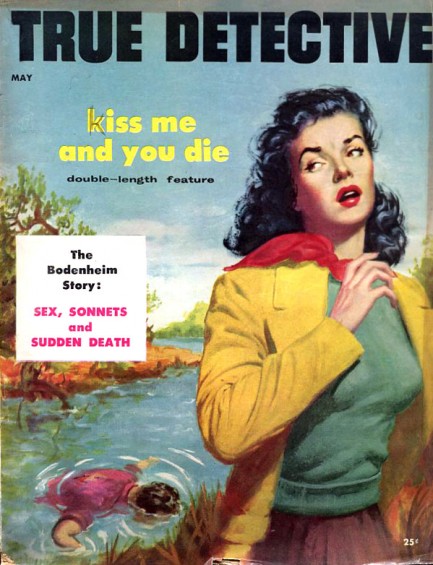
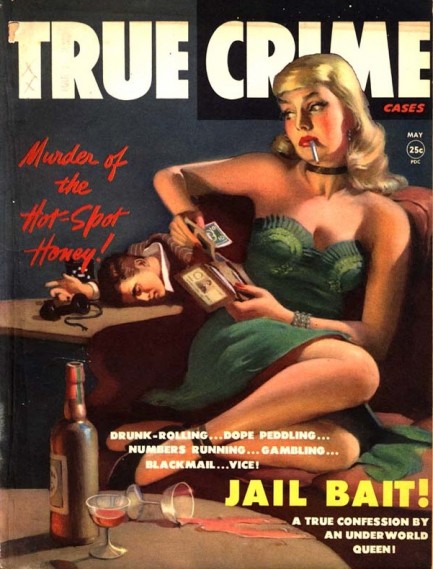
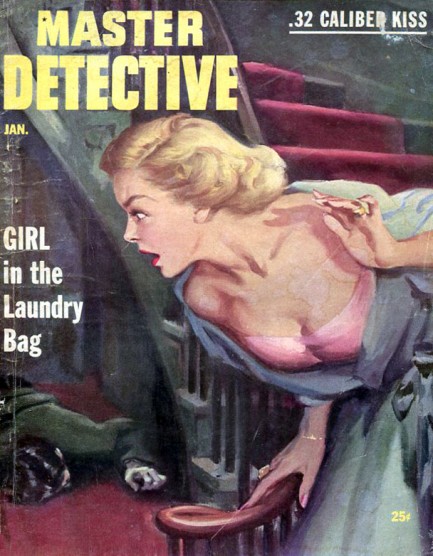
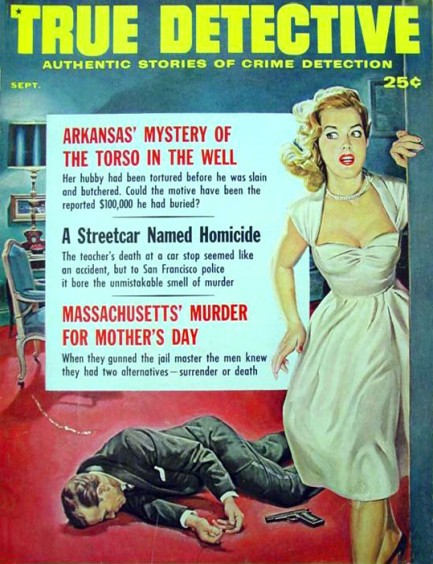
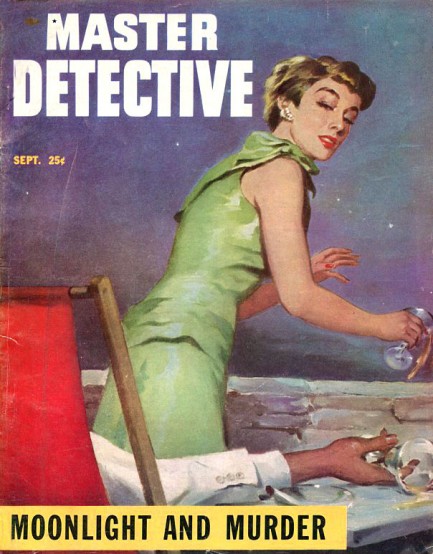
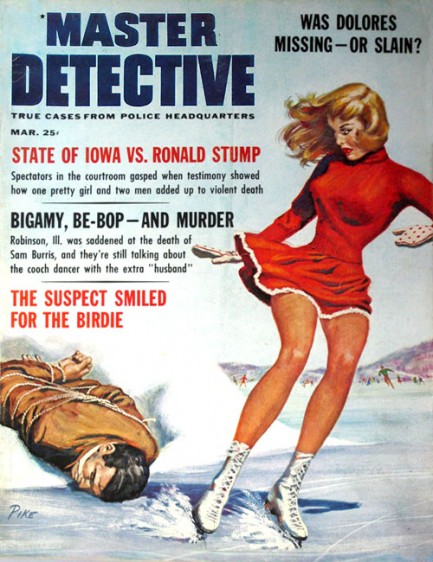
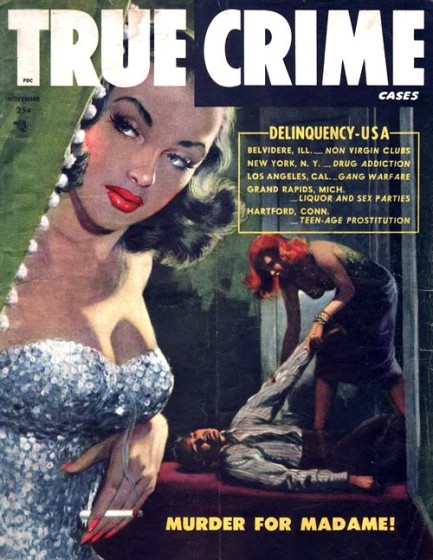
| The Naked City | May 26 2011 |

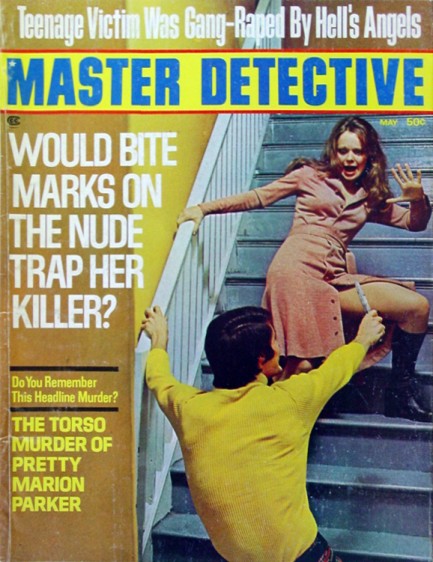
This May 1973 issue of the true crime magazine Master Detective delves back more than four decades to examine one of the most infamous murders committed in early twentieth century America. The victim was a 12-year old Los Angeles girl named Marion Parker, and on December 15, 1927, she was abducted from her school by a man who used to work for her father. The man—nineteen-year-old William Edward Hickman—came to the school and told the registrar that the girl’s father had been in an accident that morning and wished to see his daughter. It was not policy to release children to anyone other than their parents, but swayed by Hickman’s measured urgency and apparent sincerity, the registrar released Marion Parker into his custody.
Hickman was after money. Marion Parker’s father, a banker named Perry Parker, had it in abundance. For the next few days Hickman sweated Perry Parker, sending pleading notes written by Marion, as well as other notes demanding a ransom. Hickman signed the latter with various pseudonyms, but one in particular stuck with the press—“The Fox.” Eventually, Parker and Hickman agreed on a ransom of $1,500, to be paid 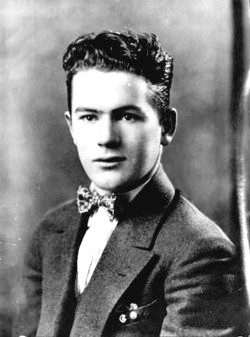 in $20 gold certificates. The first attempt at an exchange failed when Hickman noticed a cop near the meeting place. It’s unclear whether the policeman was part of a trap, but Hickman was taking no chances. He bailed, and set up a second meeting for a few nights later.
in $20 gold certificates. The first attempt at an exchange failed when Hickman noticed a cop near the meeting place. It’s unclear whether the policeman was part of a trap, but Hickman was taking no chances. He bailed, and set up a second meeting for a few nights later.
When Parker reached the rendezvous point he saw Hickman sitting in a parked car. Parker approached the driver side window and saw that the kidnapper was aiming a gun, and he also saw his daughter in the passenger seat, bundled up to her neck in a blanket. She couldn’t move—that was clear. She didn’t speak. Hickman took the ransom and drove quickly away, stopping just long enough to push Marion Parker out of the car at the end of the block. When Parker reached his daughter and lifted her into his arms he screamed in anguish. Marion was dead, and had been for twelve hours. Hickman had cut off her arms and legs, flayed the skin from her back, disemboweled her, and stuffed her with rags. She had been bundled up to conceal the fact that she had no limbs. Her eyes had been wired open so that she would, upon cursory inspection, appear to be alive.
Hickman had escaped, but he had left behind a clue that would lead to his capture. Among the rags he had stuffed into Marion Parker’s empty abdomen was a shirt with a laundry mark that police were able to trace to an address in Los Angeles. Twenty cops descended on a residence that turned out to be occupied by a man named Donald Evans, who was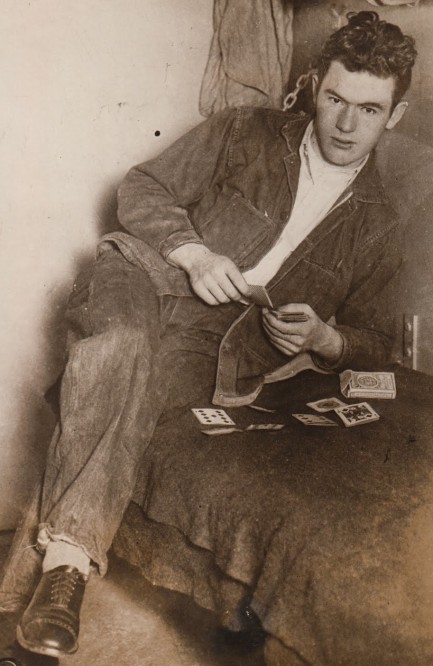 cooperative but said he knew nothing about Hickman. In truth Evans was Hickman, but by the time police figured that out he had fled to the Pacific Northwest. But he hadn’t run far enough. Wanted posters reached every corner of the west coast within days, and just one week after Hickman’s disappearance two police officers in the town of Echo, Oregon recognized him and arrested him.
cooperative but said he knew nothing about Hickman. In truth Evans was Hickman, but by the time police figured that out he had fled to the Pacific Northwest. But he hadn’t run far enough. Wanted posters reached every corner of the west coast within days, and just one week after Hickman’s disappearance two police officers in the town of Echo, Oregon recognized him and arrested him.
At trial, Hickman claimed to be guided by voices—one of the first times, if not the first, that this type of insanity defense was attempted in an American courtroom. But the jury wasn’t buying any of it and they convicted Hickman of murder and kidnapping. The judge sentenced him to be executed at San Quentin State Prison, and he climbed the stairs to the gallows on October 19, 1928. Hickman had once been smooth enough to talk a school official into sending Marion Parker to her doom, and had calmly lied about his identity to twenty cops who had burst into his house. In prison he had corresponded with and impressed author Ayn Rand so much that she decided to base a character on him because he embodied her mythical “Nietzschean Superman” ideal. But at the end, all of Hickman’s considerable aplomb deserted him. Just before the hangman sprang the trapdoor that would cast him into oblivion, he collapsed babbling in fear. His last words were, “Oh my God! Oh my God!”
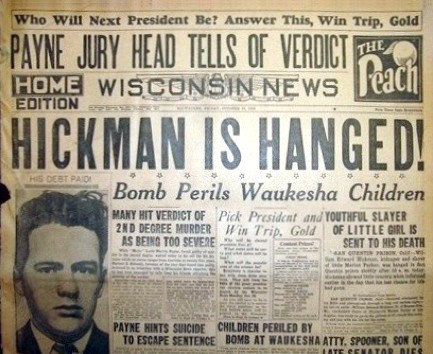
| The Naked City | Vintage Pulp | Oct 28 2010 |

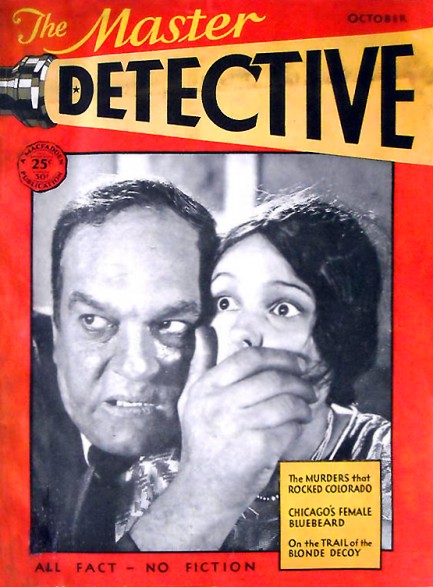
Above is an October 1930 issue of The Master Detective with an article on “Chicago’s Female Bluebeard,” aka Belle Gunness, a Norwegian-born serial killer who offed practically everyone she ever knew over the course of eight years between 1900 and 1908. Records are spotty, but what is known of the story is mightily intriguing. Her first victim may have been her husband, a butcher named Mads Ditlev Anton Sorenson, who took sick and died on the only day when an expiring insurance policy and a new one happened to overlap. However, it’s possible Belle might have already killed two of the couple’s four kids. Officially, the children died of colitis. Colitis has symptoms similar to those for certain types of poisoning, but no inquest was convened, even though Gunness owned insurance policies on both kids. In the case of her husband, questions were asked, but forensic science being what it was back then, no evidence of foul play was uncovered. Cleared of wrongdoing, Gunness left Chicago.
In 1902, now living on a farm in LaPorte, Indiana she had bought with insurance money, Gunness met and married another Norwegian—Peter Gunness, a local butcher. This man who already shared her last name had two young daughters. One of the girls died of a sudden stomach ailment shortly after the wedding, then Peter himself died when a sausage-grinding machine fell on his head, splitting his skull and killing him instantly. At least, that what it looked like. But what had actually happened is that Belle Gunness had hit him with a cleaver. It should be mentioned that she was about five-nine, went 200 pounds and was physically strong. Belle Gunness was charged with murder, but in the absence of solid forensic evidence, the case hinged on hearsay—namely, that of Gunness’s adopted daughter Jennie Olson, 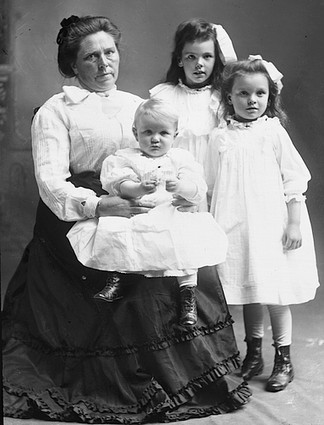 who had told a classmate, “My mama killed my papa. She hit him with a cleaver and he died.” But Olson refused to repeat the statement in court and, since Belle was pregnant, the jury acquitted her. Not long after, young Jennie Olson vanished.
who had told a classmate, “My mama killed my papa. She hit him with a cleaver and he died.” But Olson refused to repeat the statement in court and, since Belle was pregnant, the jury acquitted her. Not long after, young Jennie Olson vanished.
Belle Gunness had acquired butchery skills, and these would soon come in handy. In a local paper she bought an ad in which she described herself as a widow looking for a gentleman. The suitors came calling and the corpses began piling up. It’s impossible to say for sure how many she murdered. Only one fact is certain—she began ordering lots of steamer trunks. The only reason Belle Gunness was ever caught is because her live-in farmhand, a man named Ray Lamphere, had fallen in love with her. Lamphere was well aware of Belle’s activities, and began to make thinly veiled threats when it became clear she wasn’t interested in him. Belle retaliated by firing him then trying to get him locked in an asylum, and Lamphere retaliated in turn by arousing the suspicions of a man whose brother had gone missing on the farm. In the end, she had no choice to but to agree to a police search of the place. The game was up, but that didn’t mean she had to stick around for the conclusion.
On April 28, 1908 the Gunness farmhouse caught fire. By the time emergency crews arrived the place was cinders. In the basement four bodies were found—those of Gunness’s three children and the body of a woman that couldn’t be identified because it was headless. The headlessness pointed to murder, and so police arrested Ray Lamphere. They believed he had killed Belle Gunness and her children, then set the 
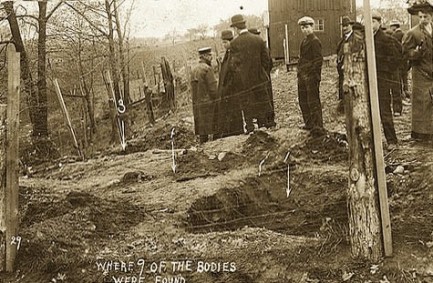 fire to cover up his crime. Continued digging in the basement finally unearthed Belle Gunness’s dental bridge near where the unidentified corpse had been found. It seemed Gunness was dead. Meanwhile, evidence of serial murder emerged when excavations in the farm’s hog pen, pictured above, uncovered a mass grave. Inside was interred the body of Jennie Olson and many other victims. The morbid case became a nationwide sensation.
fire to cover up his crime. Continued digging in the basement finally unearthed Belle Gunness’s dental bridge near where the unidentified corpse had been found. It seemed Gunness was dead. Meanwhile, evidence of serial murder emerged when excavations in the farm’s hog pen, pictured above, uncovered a mass grave. Inside was interred the body of Jennie Olson and many other victims. The morbid case became a nationwide sensation.
At trial Ray Lamphere had a novel defense—he said he wasn’t guilty of murder because Belle Gunness wasn’t dead. The jury agreed there was indeed reasonable doubt about this—the body from the fire was about six inches shorter than Gunness, even accounting for the missing head. Lamphere was acquitted of murder but jailed for arson. He would last in prison only for a year before dying of consumption, but before his death he told the whole story. According to him, Belle had been killing for years, usually with a cleaver to the skull or chloroform. She would then dismember the bodies using her butchery skills, and he would help bury the pieces. The motive was simple—Belle was hungry for money. The killings sometimes triggered insurance payments; other times Belle killed after suitors had lent her large amounts of cash.
Ray explained that when the LaPorte police began nosing around, he and Belle forgot their differences and worked out a plan to escape town together. She killed her three children and a local woman whose body would serve as a decoy, left them in the basement of the farmhouse with her dental bridge, and dumped the decapitated head in a swamp. Lamphere torched the place, and they were to meet at a crossroads like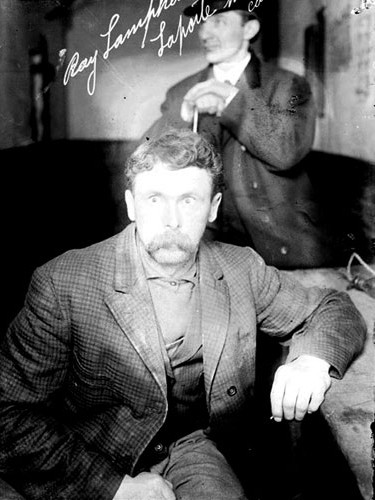 eloping lovers and venture forth toward their new lives. Instead, Lamphere claimed Gunness cut across a deserted wood and ditched him. According to him, she escaped with all the cash from her various insurance murders and scams—some $250,000, or about 7 million in modern money. A check of local banks revealed that her accounts had been emptied just before the fire. Belle Gunness—killer of forty-two people according to Ray Lamphere—had outsmarted everyone and vanished for parts unknown with a fortune.
eloping lovers and venture forth toward their new lives. Instead, Lamphere claimed Gunness cut across a deserted wood and ditched him. According to him, she escaped with all the cash from her various insurance murders and scams—some $250,000, or about 7 million in modern money. A check of local banks revealed that her accounts had been emptied just before the fire. Belle Gunness—killer of forty-two people according to Ray Lamphere—had outsmarted everyone and vanished for parts unknown with a fortune.
The Gunness case is one of particular interest to murder historians, partly because the lack of solid records leaves so many gaps in the narrative. The summary you’ve just read follows one line of reasoning, but in truth, there is doubt about where she lived and when, who she met and when, and even how many children she had. There are many questions over whether she actually escaped. Some believe Lamphere killed her and ditched the body. There is also a theory, supported by intriguing circumstantial evidence, that she went on to kill more people in California. DNA tests on Gunness descendants might clear up some questions, but these are pending as of today. In any case, it’s safe to say that Belle Gunness is one of the most accomplished killers who ever lived. Her story—whichever one you prefer—proves once again what we always say here at Pulp Intl. The world hasn’t grown crueler. It was always that way.
| The Naked City | Vintage Pulp | Oct 7 2010 |

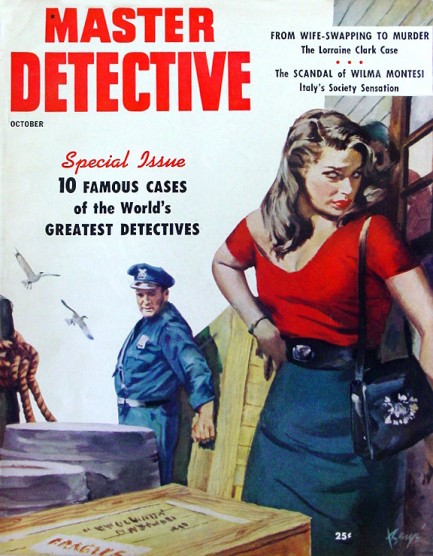
We double up on the murders today, thanks to the always informative true crime magazine Master Detective. This issue is from October 1954, with Barye Phillips cover art, and amongst the horrors revealed is one involving Massachusetts spouses Melvin and Lorraine Clark. The Clarks were heavy into key-swapping parties, at which opposite sexes blindly selected each other's keys from a bowl or sack to randomly determine who would be whose companion for the evening. If you’ve ever seen the Sigourney Weaver movie The Ice Storm, it was exactly like that—a few drinks, a few joints, and some freewheeling, no-strings-attached sex.
But when Melvin came home the night of April 10, 1954, and found Lorraine in bed with another man outside the context of a swapping party, an argument ensued that escalated to the point where Lorraine stabbed her husband with a knitting needle and shot him twice. She wrapped Melvin’s body in chicken wire, weighed him down with a cement block or two, and dumped him off Rocks Village Bridge into the Merrimack River, where the current was supposed to carry him out to sea.
She wrapped Melvin’s body in chicken wire, weighed him down with a cement block or two, and dumped him off Rocks Village Bridge into the Merrimack River, where the current was supposed to carry him out to sea.
Lorraine never expected to see her husband again we can be sure, and even filed for divorce as part of her cover story, claiming he had abandoned her after a bitter confrontation. But Melvin hadn’t abandoned her—in fact, he hadn’t gone far at all. A bird watcher found his mostly skeletonized body in a riverside marsh in early June.
Under police questioning Lorraine caved in pretty much immediately and, long story short, earned a life sentence in federal prison. She never named an accomplice, but no bodybuilder she, it seemed clear she could not have done the heavy lifting involved in the murder without a helping hand. Also, for someone who had little to no experience with firearms, she sure had good aim. Melvin had taken one in the forehead and one in the temple. But Mrs. Clark was not pressed to name a partner in crime, did her time in silence, and was eventually paroled. In retrospect, you wonder if local bigwigs wanted the case to go away. After all, you meet the most interesting people when you swap.
Master Detective treats us to a second fascinating story, this one on Italian fashion model Wilma Montesi, who in April 1953 was found dead on Plinius Beach near Ostia, Italy. Police declared her death a suicide or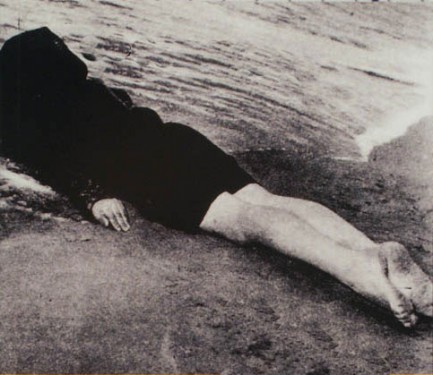 accidental drowning—case closed. But the public had many questions. How had she drowned in just a few inches of water? If it was suicide, why had she shown no signs of depression? Why were her undergarments in disarray? The police weren’t keen to reopen the case, but agreed to an informal re-investigation. Weeks later they announced once more: suicide or accidental drowing. But the public suspected cops weren’t trying to reach any other conclusion.
accidental drowning—case closed. But the public had many questions. How had she drowned in just a few inches of water? If it was suicide, why had she shown no signs of depression? Why were her undergarments in disarray? The police weren’t keen to reopen the case, but agreed to an informal re-investigation. Weeks later they announced once more: suicide or accidental drowing. But the public suspected cops weren’t trying to reach any other conclusion.
When the editor of the neo-fascist paper Attualita charged in print seven months later that Wilma Montesi had not gone to Ostia the day of her death, but to a fancy hunting lodge in nearby Capocotto, the story was not just ignored—Italian authorities hauled the editor before a court and threatened him with charges for spreading false information. But his tale was backed up by a witness—Anna Maria Caglio, who had spent time at the lodge and dropped a bomb on Italian society when she said it was a front for drugs and sex parties—sort of like The Ice Storm again, but with much richer and more powerful people involved. By powerful, 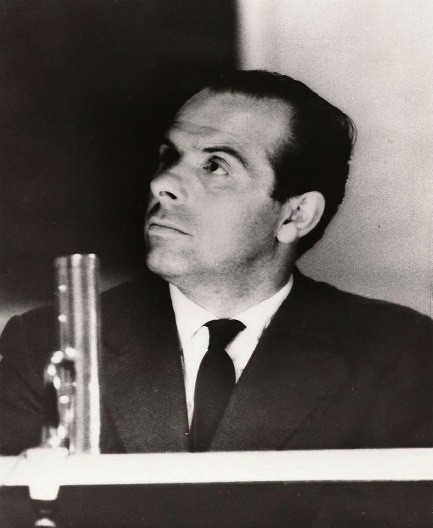 we're talking about judges, politicians, the Pope’s personal physician and other Vatican officials, and the well-connected Foreign Minister’s son Piero Piccioni, who you see pictured just above.
we're talking about judges, politicians, the Pope’s personal physician and other Vatican officials, and the well-connected Foreign Minister’s son Piero Piccioni, who you see pictured just above.
When the national Communist party began making waves, the carabinièri—Italy’s military police—stepped in. Like the local cops, they weren’t keen to pursue the case, but they weren’t about to let the Communists break it open and potentially expose the corruption of the entire political establishment. The carabinièri’s involvement angered many upper crust Italians, but when their officers walked the streets during those months the general public literally applauded them for daring to tread where the police had not.
Their investigation soon focused on Piccioni, who besides being the scion of a political family was a famous jazz composer. But Piccioni had an alibi—at the time of the murder he was in the house of actress Alida Valli in Amalfi, where he claimed to be sick in bed. Rumors sprang up that he was Valli’s lover. Why did anyone care? Because Valli, a big star at the time who had appeared in Orson Welles’ The Third Man, was married to another famous musician, Oscar de Mejo. The case was now a full-blown media circus.
This is the way it may have gone: every direction the carabinièri turned, politically connected Italians threw up walls in their path. Alternatively, it may have gone like this: the carabinièri made a noisy show of annoying a few heavy hitters, but were only performing for a suspicious and cynical public. What was clear 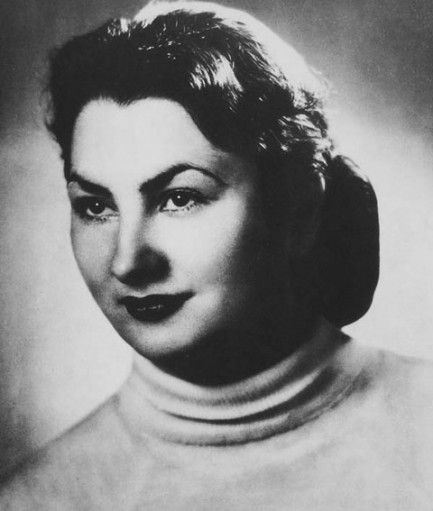 was very powerful people wanted the orgiastic activities in Capacotto forgotten.
was very powerful people wanted the orgiastic activities in Capacotto forgotten.
Behind the scenes manuvering was rife. Anna Maria Caglio even wrote a letter to the Pope warning him that there were people around him who meant him harm, presumably because they wanted to expose the involvement of Vatican officials in the late night shenanigans at the lodge. Pressure came down from the highest levels of the Italian establishment to put the case to bed quickly. It wasn’t quick.
But neither was it necessarily thorough. Eventually four people were brought to trial, including Piero Piccioni. All were acquitted. Perhaps the only consequence of the investigation is that it became one of the most celebrated mysteries of all time, inspiring many books, and even a symbolic reference in the incomparable Federico Fellini film La Dolce Vita. But what really happened to Wilma Montesi? Nobody knows. Today the case is still unsolved.
| Vintage Pulp | Aug 30 2010 |

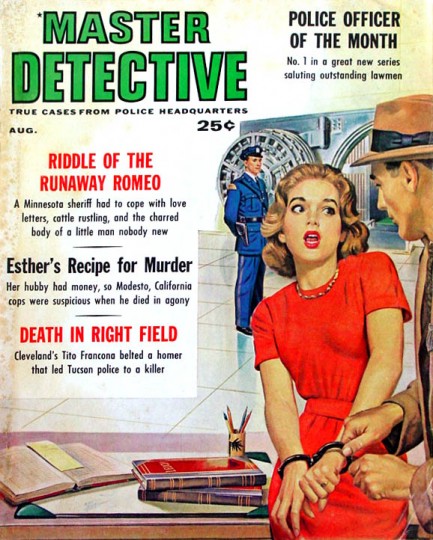
Above is an August 1962 Master Detective with great cover art of a lady in red being taken into custody, and clearly this isn’t a Wall Street bank she works at, because at those taxpayers’ money is free for the taking. Since it’s getting toward the best part of baseball season over in the U.S., the blurb that intrigued us the most on this cover was the final one, telling us that Tito Francona—father of current Boston Red Sox manager Terry Francona—was somehow involved in solving a murder. We’re told that he “belted a homer that led Tucson police to a killer”, and we were expecting the story to be some kind of convoluted mystery. But no—the blurb is meant literally. Francona hit a home run during a Cleveland Indians spring training game in Tucson and the ball actually landed next to a body that was hidden in brush beyond the right field wall. The body belonged to a fugitive who was wanted for the murder of his unfaithful wife’s lover. He had chosen that unlikely spot to commit suicide by shooting himself. Case solved. So Francona didn’t exactly enter stage right and help unravel a Da Vinci Code style puzzle, but the story is still an interesting historical footnote. Baseball is the type of sport where players and fans tend to believe in curses, so maybe a purification ceremony where the body was found would help the Indians finally win a World Series. It’s been sixty-two years and counting.





































































